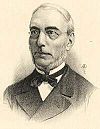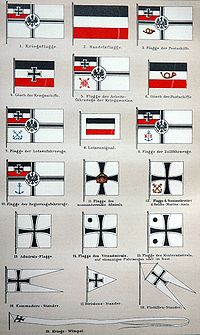Portal:Heraldry
Welcome to the Heraldry and Vexillology Portal!


Heraldry encompasses all of the duties of a herald, including the science and art of designing, displaying, describing and recording coats of arms and badges, as well as the formal ceremonies and laws that regulate the use and inheritance of arms. The origins of heraldry lie in the medieval need to distinguish participants in battles or jousts, whose faces were hidden by steel helmets.
Vexillology (from the Latin vexillum, a flag or banner) is the scholarly study of flags, including the creation and development of a body of knowledge about flags of all types, their forms and functions, and of scientific theories and principles based on that knowledge. Flags were originally used to assist military coordination on the battlefield, and have evolved into a general tool for signalling and identification, particularly identification of countries.
Selected biography

Johannes Baptista Rietstap (12 May 1828–24 December 1891) was a Dutch heraldist and genealogist, who is often considered to be the father of modern heraldry in the Netherlands. Rietstap was proficient in English, French, German, Spanish and Latin in addition to his mother tongue, and from the 1850s to the 1870s published a large number of translations of both fiction and non-fiction works. He also worked as a stenographer for the Staten-Generaal for 37 years, eventually rising to the position of First Stenographer. He is most well-known however for his publication of the Armorial Général. This monumental work contains the blazons of the coats of arms of more than 130,000 European families, and is still one of the most complete works of its kind. (more...)
Selected coat of arms

The seal of Indiana is used by the Governor of Indiana to certify official documents. The seal has gone through several revisions since the region was a part of the Northwest Territory. It is likely the original seal, which is similar to the current one, was created by William Henry Harrison during his administration of the Indiana Territory. The current design of the seal was standardized by the Indiana General Assembly in 1963.
The sun rising in the picture represents that Indiana has a bright future ahead and is just beginning. The mountains it rises over are a representation of the Allegheny Mountains showing that Indiana is in the west. The woodman represents civilization subduing the wilderness that was Indiana. The buffalo represents the wilderness fleeing westward away from the advancing civilization. (more...)
Selected flag

The flag of Australia was chosen in 1901 from entries in a worldwide design competition held following Federation. It was approved by Australian and British authorities over the next few years, although the exact specifications of the flag were changed several times both intentionally and as a result of confusion. The current specifications were published in 1934, and in 1954 the flag became legally recognised as the "Australian National Flag". The flag is a defaced Blue Ensign: a blue field with the Union Flag in the canton (upper hoist quarter), and a large white seven-pointed star known as the Commonwealth Star in the lower hoist quarter. The fly contains a representation of the Southern Cross constellation, made up of five white stars – one small five-pointed star and four, larger, seven-pointed stars. (more...)
Selected picture

Flags used by the German Kaiserliche Marine (Imperial Navy), 1892.
Did you know...
- ...that in the coat of arms of Schleswig-Holstein (pictured) the lions in the Schleswig arms allegedly face the right because Otto von Bismarck thought it impolite for them to turn their backs on Holstein?
- ...that Donal McLaughlin, as part of a team led by Oliver Lincoln Lundquist, designed a logo for the 1945 United Nations Conference on International Organization that became the model for the Flag of the United Nations?
- ...that in 1817, the previously banned coat of arms of Paris was restored to its traditional form?
- ...that the Pennon, one of the principal varieties of flag carried during the Middle Ages, derives its name from the Latin penna, meaning wing?
Related portals
Major topics and navigation
|
|
|
Heraldry Web resources
Authorities
- Belgium - The Council of Nobility, Flemish Heraldic Council and Council of Heraldry and Vexillology of the French Community
- Canada - Canadian Heraldic Authority and see also Public Register of Arms, Flags and Badges
- England, Wales, and Northern Ireland - The College of Arms
- Ireland - The Office of the Chief Herald of Ireland
- Netherlands - High Council of Nobility
- Portugal - Instituto da Nobreza Portuguesa
- Scotland - The Court of the Lord Lyon
- South Africa - South African Bureau of Heraldry
- Sweden - National Board of Heraldry, The National Archive
- United States Army - The United States Army Institute of Heraldry
Societies
- Greek Heraldry Society
- The Academy of Heraldic Science Czech republic
- The American College of Heraldry
- The American Heraldry Society
- The Augustan Society
- The Australian Heraldry Society Inc.
- Bulgarian Heraldry and Vexillology Society
- The Center for Research of Orthodox Monarchism
- Cambridge University Heraldic and Genealogical Society
- Chiltern Heraldry Group
- The College of Dracology
- Croatian Heraldic and Vexillologic Association
- The Finnish Heraldic Society
- Fryske Rie foar Heraldyk
- Hellenic Armigers Society
- Guild of Heraldic Artists
- Genealogical Society of Ireland
- Heraldry Research Institute (Japan)
- The Heraldry Society
- The Heraldry Society of Africa
- The Heraldry Society of New Zealand Inc.
- The Heraldry Society of Scotland
- The Heraldry Society of Southern Africa
- The Institute of Heraldic and Genealogical Studies
- The International Association of Amateur Heralds
- Italian Center of Vexillological Studies
- Lancashire Heraldry Group
- Macedonian Heraldry Society
- New England Historic Genealogical Society Committee on Heraldry
- Norwegian Heraldry Society
- Oxford University Heraldry Society
- Polish Heraldry Society
- Polish Nobility Confederation
- Real Academia Matritense de Heráldica y Genealogía - Royal Academy of Heraldry and Genealogy of Madrid
- Romanian Institute for Genealogy and Heraldry
- The Royal Heraldry Society of Canada
- The Russian College of HeraldryThe Russian College of Heraldry
- Serbian Heraldic Society
- Societas Heraldica Scandinavica
- Societas Heraldica Slovenica
- Swedish Heraldic Society
- Ukrainian Heraldry Society
- Royal Association Genealogical and Heraldic Office of Belgium
Vexillology
Software
- Coat of Arms Visual Designer web-based program
- Puncher Heraldry Program
- Blazonry Server - pyBlazon
- DrawShield - creates SVG shield or arms image from blazon
- CoaMaker - web-based tool
- Blazon95 and BLAZONS! 2000, older Windows applications
- Heraldicon
Texts
- Heraldry, historical and popular : with seven hundred illustrations (1863)
- A Complete Guide to Heraldry (1909)
Other
Wikimedia
The following Wikimedia Foundation sister projects provide more on this subject:
-
Commons
Free media repository -
Wikibooks
Free textbooks and manuals -
Wikidata
Free knowledge base -
Wikinews
Free-content news -
Wikiquote
Collection of quotations -
Wikisource
Free-content library -
Wikispecies
Directory of species -
Wikiversity
Free learning tools -
Wikivoyage
Free travel guide -
Wiktionary
Dictionary and thesaurus












